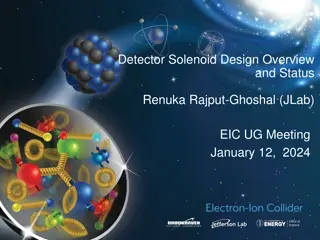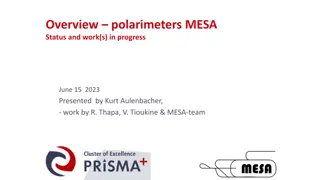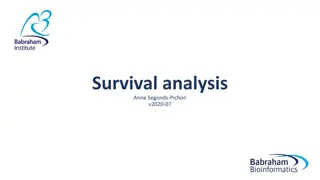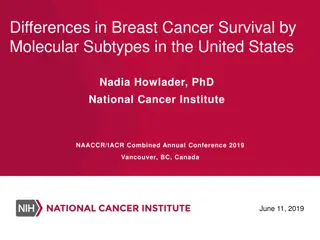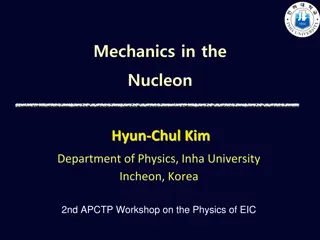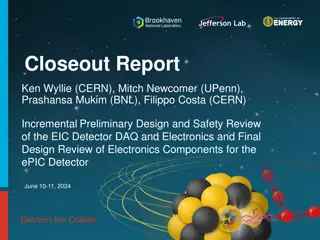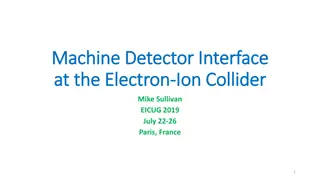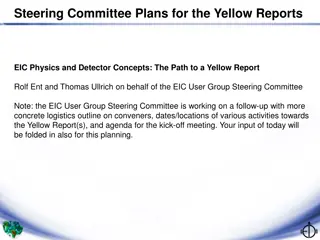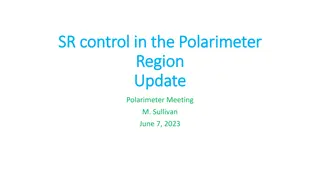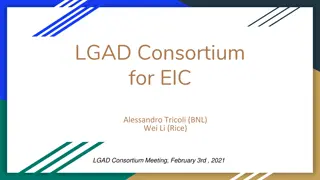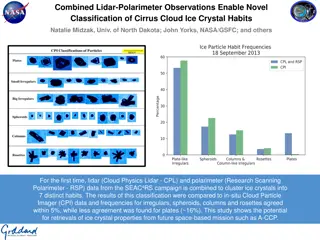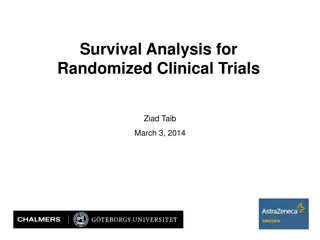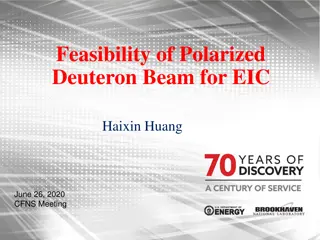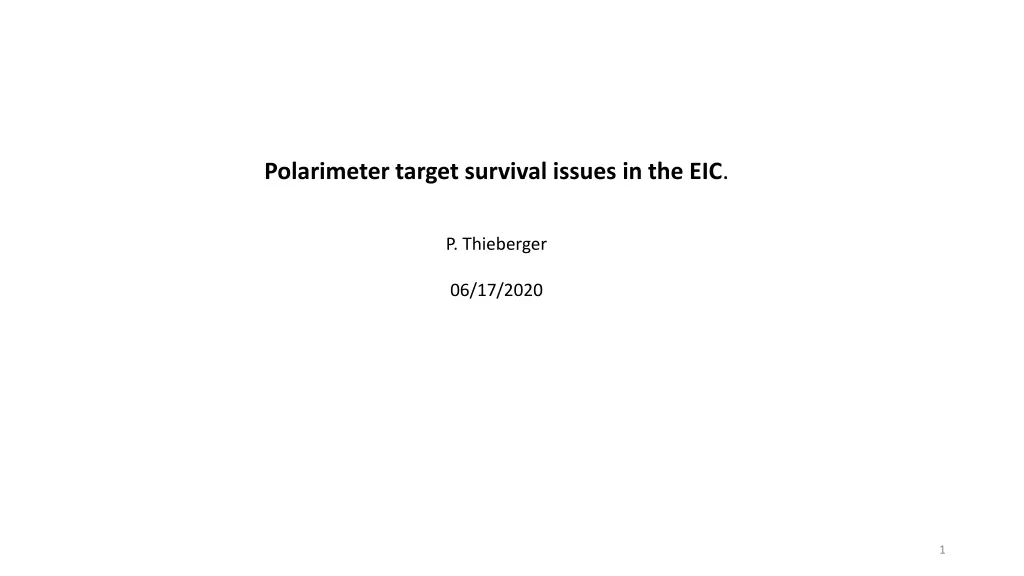
Polarimeter Target Survival Issues in EIC: Understanding RF Heating and Beam Effects
Learn about the challenges of polarimeter target survival in the EIC due to RF heating and beam effects, with insights on failure mechanisms, target lifetime estimates, and potential solutions using cluster jet targets. Explore simulations, proton beam parameters, target holder designs, and field probe locations for a comprehensive understanding of the issue.
Download Presentation

Please find below an Image/Link to download the presentation.
The content on the website is provided AS IS for your information and personal use only. It may not be sold, licensed, or shared on other websites without obtaining consent from the author. If you encounter any issues during the download, it is possible that the publisher has removed the file from their server.
You are allowed to download the files provided on this website for personal or commercial use, subject to the condition that they are used lawfully. All files are the property of their respective owners.
The content on the website is provided AS IS for your information and personal use only. It may not be sold, licensed, or shared on other websites without obtaining consent from the author.
E N D
Presentation Transcript
Polarimeter target survival issues in the EIC. P. Thieberger 06/17/2020 1
INTRODUCTION The short lifetime of the polarimeter targets has been of concern for polarized proton runs in RHIC and, as will be shown here, will preclude their use in the EIC. The main failure mechanisms are due to RF heating and direct beam heating leading to sublimation and perhaps oxidation. RF power generated by RHI and by EIC bunches are compared by using particle Studio simulations and temperatures reached are estimated. An improved design of the target holder fins was developed that may be advantageous for the next RHIC run but will not help the EIC situation. Direct beam heating in both machines is then estimated. This effect by itself would destroy the targets almost immediately in the EIC when operated at the projected intensity. Cluster jet targets may be a good solution. 2
How hot is too hot? Target lifetime estimate at 2500 oK = 2227 oC Target thickness = 50 nm Density = 1.8 g/cm3 Area density = 50 10-7 1.8 = 9 g/cm2 Area density = 9/12 = 0.75 moles/cm2 Rate of sublimation = 2 0.017 = 0.034 moles/cm2 s Lifetime upper limit = 0.75/0.034 = 22 seconds NOTE: this is the time for 100% of the material to sublimate. The target will break before that point is reached. 3 https://aip.scitation.org/doi/pdf/10.1063/1.1672500
RHIC and EIC proton beam parameters used in these studies *. Polarized proton bunch parameters 2017 run EIC Energy (GeV) 255 275 Norm. H emittance (um) 3.6 2.8 Norm. V emittance (um) 3.6 0.45 Bunch length (cm) 60 6 Bunch intensity 2.00E+11 6.90E+10 # of bunches 111 1160 Blue sigma x (mm) 0.58 Blue sigma y (mm) 0.54 Yellow sigma x (mm) 0.85 0.72 Yellow sigma y (mm) 0.62 0.2 * Provided by Haixin Huang 4
3D models of the target holders used in the simulations* fiber Frame without fins Frame with fins 3D mesh with 5.7E6 cells * Provided by George Mahler 5
Section beam pipe used for propagating the beam to the regions of interest close to the polarimeter target holder and locations of the field probes used in the simulations Using a simplified support and smaller beam-pipe compared to the actual system has a negligible effect on the simulated field values close to the target holder. The simplification allows faster simulations and therefore more data can be generated. 6
Observation of oscillations induced by the shorter EIC bunch EIC RHIC Shown above are the electric field values at points close to the tip of the target-holder induced by a 60 cm RMS RHIC bunch and by a 6 cm RMS EIC bunch. The oscillations induced in the EIC case will need to be damped in order to reduce an additional contribution to RF heating. This can be probably achieved incorporating a dissipative ferrite element in the design of the target holder. Further simulations will be required to redesign the target holder. The electric field power estimates shown in the next slides assume that these oscillations have been totally eliminated. 7
Peak electric fields and average power densities as function of distance from center of a polarimeter target parked 25 mm away from the beam, with and without fin. This point where glowing starts was used as reference to convert power densities to temperatures The larger electric field values close to the target attachment point explain the observed glowing of the ends of the ribbons. The donut-shaped fins are effective in reducing that heating power. The right chart shows relative average electric field power density values. The fraction of this power absorbed by the ribbons depends on the complex permittivity of the material which is frequency dependent and will probably be larger for the higher frequencies generated by the shorter EIC bunches. 8
Peak electric fields and average power densities as function of distance from center of a polarimeter target parked 25 mm away from the beam, with existing and modified fins Semicircular shields added to the fins are very effective in further reducing the field at the attachment points when the target is at 25 mm form the beam. This would help if breakage at the attachment points continues limiting the target lifetime. 9
Simulated electric field values as function of position along the pC polarimeter target when inserted for RHIC and EIC proton bunches Pwr. Density when retracted The Particle Studio simulated electric field values are indicated by the solid lines. The red dotted line representing the field inside the Gaussian beam was calculated analytically for the RHIC blue beam which is approximately round. For the EIC beam the blue dotted line is only a rough approximation. The fins shield is effective in reducing the field close to the target attachment points. The power density at 2.2 mm from the attachment point is estimated to correspond to 550 oC because that is where glowing starts. This estimate is used to make the connection between power density and temperature. The results are shown on the next slide. 10
How do we get temperature estimates from the Particle Studio simulated fields? "????? ???????" ? ?????????? = 2 ?? ?????????? ???????4 ?????4 "????? ???????" are the values proportional to the actual power density obtained from the Particle Studio simulated fields. Knowing ??????? for one of these values allows us to calculate the combined value of the constants. Then we can derive ???????for all the other power density values. Absorbance and emissivity for graphite are assumed here to be constant because values don t seem to be available over the temperature and frequency range of interest. If such values became available, the calculations can be easily repeated. The results are not expected to change very significantly. 11
RF-induced temperature estimates along the target when inserted in the beam Only radiative cooling is considered. The emissivity was assumed to be temperature independent and the rf absorbance frequency and temperature independent. These are only rough approximations. But the result is probably not in question. These targets will not survive the RF heating due to the EIC beam. 12
Heating due to beam energy-loss Assumptions used for the temperature estimates dE/dx = 1.8 keV cm2/mg (close to minimum ionizing) 16 eV proton energy loss Emissivity = 0.7 Only radiative cooling is significant. Constant emissivity is used because graphite emissivity data at these temperatures is not available. 13
Cluster jet targets - a possible solution Area densities > 1E15 atoms/cm^2 have been achieved. Area densities are adjustable over many orders of magnitude. If we swept our C fiber through the beam continuously once per second at 4mm/s, that would be equivalent to a stationary target thickness of 2.25E15 atoms/cm^2. Continuous counting instead of counting in short bursts will allow a very large increase in data collection efficiency. That counting efficiency increase may allow us to use one or a few pilot bunches separated enough from the bunch-train to solve the time-of-flight problem with the 10 ns bunch spacing in the EIC. Possible gasses that could be used include H2, N2 and O2. Maintaining good vacuum is much less challenging compared to supersonic gas jets. That will not be a major problem. The largest challenge is to learn and develop this new technology. But we have at least a few years to do that. A cryogenic supersonic jet target for electron scattering experiments at MAGIX@MESA and MAMI. S. Grieser, et.al, NIM A 906 (2018) 120-126 14
Conclusions Solid targets for proton polarimetry will not survive in EIC operating at design intensities. The present shape of the fins can be improved for RHIC polarimetry in case breakage at the attachment points is still significant. Cluster jet targets may be an attractive solution for EIC by providing fixed targets. The increased yield from these fixed targets may make it possible to preform polarimetry on one or a few pilot bunches separated well enough from the 10ns spaced bunch train to allow accurate time- of-flight measurements. 16

